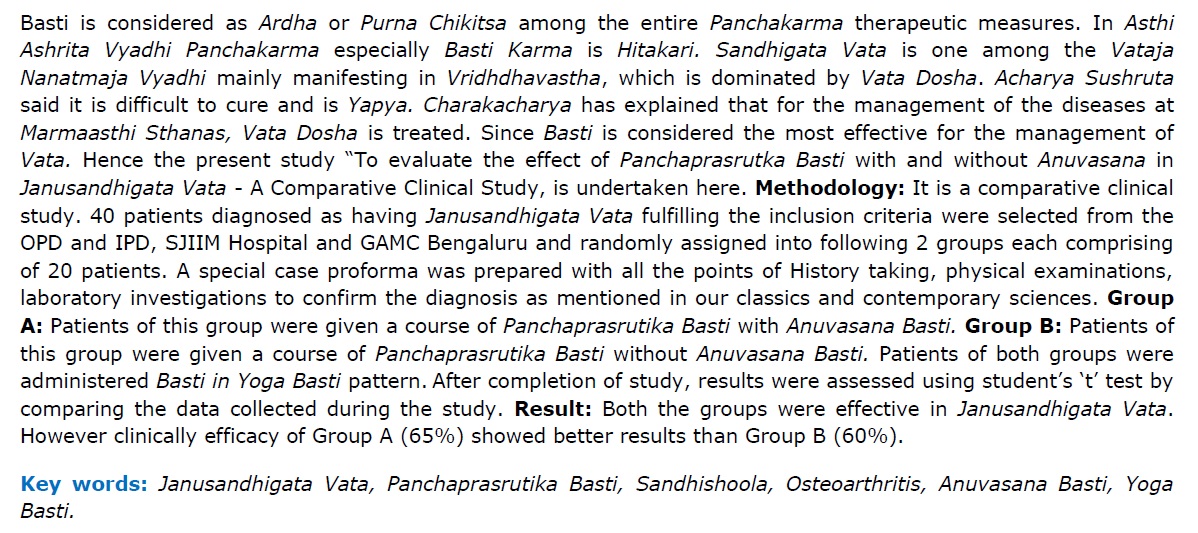To evaluate the effect of Panchaprasrutika Basti with and without Anuvasana in Janusandhigata Vata - A Comparative Clinical Study
DOI:
https://doi.org/10.21760/jaims.v6i5.1479Keywords:
Janusandhigata Vata, Panchaprasrutika Basti, Sandhishoola, Osteoarthritis, Anuvasana Basti, Yoga Basti.Abstract
Basti is considered as Ardha or Purna Chikitsa among the entire Panchakarma therapeutic measures. In Asthi Ashrita Vyadhi Panchakarma especially Basti Karma is Hitakari. Sandhigata Vata is one among the Vataja Nanatmaja Vyadhi mainly manifesting in Vridhdhavastha, which is dominated by Vata Dosha. Acharya Sushruta said it is difficult to cure and is Yapya. Charakacharya has explained that for the management of the diseases at Marmaasthi Sthanas, Vata Dosha is treated. Since Basti is considered the most effective for the management of Vata. Hence the present study “To evaluate the effect of Panchaprasrutka Basti with and without Anuvasana in Janusandhigata Vata - A Comparative Clinical Study, is undertaken here. Methodology: It is a comparative clinical study. 40 patients diagnosed as having Janusandhigata Vata fulfilling the inclusion criteria were selected from the OPD and IPD, SJIIM Hospital and GAMC Bengaluru and randomly assigned into following 2 groups each comprising of 20 patients. A special case proforma was prepared with all the points of History taking, physical examinations, laboratory investigations to confirm the diagnosis as mentioned in our classics and contemporary sciences. Group A: Patients of this group were given a course of Panchaprasrutika Basti with Anuvasana Basti. Group B: Patients of this group were given a course of Panchaprasrutika Basti without Anuvasana Basti. Patients of both groups were administered Basti in Yoga Basti pattern. After completion of study, results were assessed using student’s ‘t’ test by comparing the data collected during the study. Result: Both the groups were effective in Janusandhigata Vata. However clinically efficacy of Group A (65%) showed better results than Group B (60%).
Downloads
References
Health world website https://www.ncbi:nlm.nih.gov
Agnivesha, Chakradatta Charaka Samhita, commentary by Vaidya Jadavji Trikamji Acharya, Reprint:2009, Varanasi, Choukambha Orientalia, Chikitsa sthana 28/37, p618.
API text book of medicine, edited by Siddarth N Shah, Ex editor M. Paul Anand, 7th edition 2003, chapter 19, p1154
Agnivesha, Charaka Samhita revised by Charaka and Dridhabala with introduction by Vaidya Samrat Sri Satyanayana Shastri Padmabhushana with elaborated Vidyotini Hindi commentary by Pt Kashinath Shastri and Gorakhnath Chaturvedi, Reprint 2005, Chaukhambha Bharati Academy, Varanasi. Sutrasthan 28/27, p 573.
Agnivesha, Charaka Samhita; Pandit Kashinath Shastri and Dridhabala by Pt Kashinath Shastri and Gorakhnath Chaturvedi, Reprint 2009, published by Chaukhambha Bharati Academy, Varanasi. Siddisthana 9/7, p1053.
Sharangadharacharya. Sharangadhara Samhita - with the commentaries Adhamalla’s Deepika and Kashirama’s Gudhartha Deepika, Reprint 2000. Varanasi: Krishnadas Academy; 2000.















